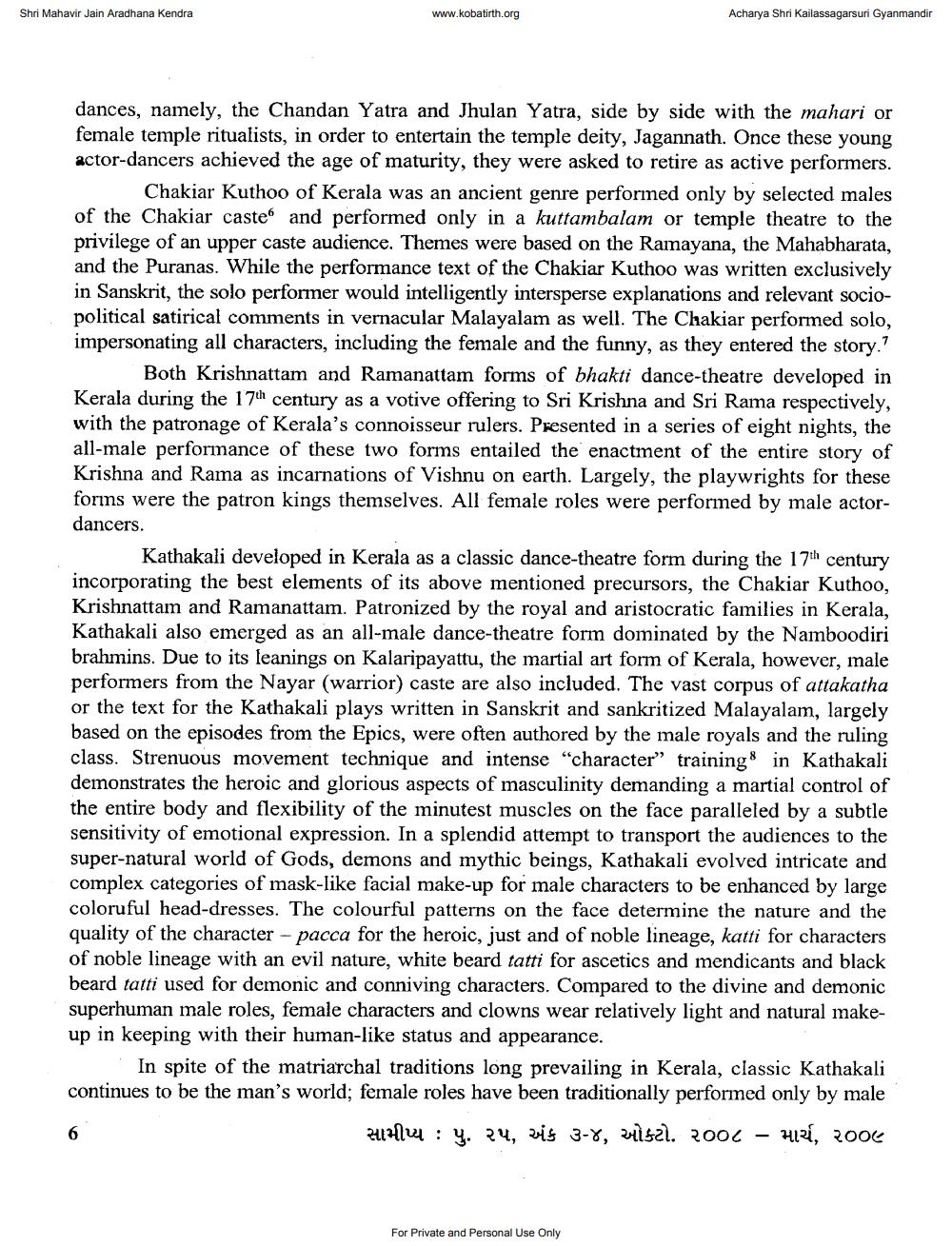Book Title: Samipya 2008 Vol 25 Ank 03 04 Author(s): R T Savalia Publisher: Bholabhai Jeshingbhai Adhyayan Sanshodhan Vidyabhavan View full book textPage 9
________________ Shri Mahavir Jain Aradhana Kendra www.kobatirth.org Acharya Shri Kailassagarsuri Gyanmandir dances, namely, the Chandan Yatra and Jhulan Yatra, side by side with the mahari or female temple ritualists, in order to entertain the temple deity, Jagannath. Once these young actor-dancers achieved the age of maturity, they were asked to retire as active performers. Chakiar Kuthoo of Kerala was an ancient genre performed only by selected males of the Chakiar caste and performed only in a kuttambalam or temple theatre to the privilege of an upper caste audience. Themes were based on the Ramayana, the Mahabharata, and the Puranas. While the performance text of the Chakiar Kuthoo was written exclusively in Sanskrit, the solo performer would intelligently intersperse explanations and relevant sociopolitical satirical comments in vernacular Malayalam as well. The Chakiar performed solo, impersonating all characters, including the female and the funny, as they entered the story? Both Krishnattam and Ramanattam forms of bhakti dance-theatre developed in Kerala during the 17th century as a votive offering to Sri Krishna and Sri Rama respectively, with the patronage of Kerala's connoisseur rulers. Presented in a series of eight nights, the all-male performance of these two forms entailed the enactment of the entire story of Krishna and Rama as incarnations of Vishnu on earth. Largely, the playwrights for these forins were the patron kings themselves. All female roles were performed by male actordancers. Kathakali developed in Kerala as a classic dance-theatre form during the 17th century incorporating the best elements of its above mentioned precursors, the Chakiar Kuthoo, Krishnattam and Ramanattam. Patronized by the royal and aristocratic families in Kerala, Kathakali also emerged as an all-male dance-theatre form dominated by the Namboodiri brahmins. Due to its leanings on Kalaripayattu, the martial art form of Kerala, however, male performers from the Nayar (warrior) caste are also included. The vast corpus of attakatha or the text for the Kathakali plays written in Sanskrit and sankritized Malayalam, largely based on the episodes from the Epics, were often authored by the male royals and the ruling class. Strenuous movement technique and intense "character" training in Kathakali demonstrates the heroic and glorious aspects of masculinity demanding a martial control of the entire body and flexibility of the minutest muscles on the face paralleled by a subtle sensitivity of emotional expression. In a splendid attempt to transport the audiences to the super-natural world of Gods, demons and mythic beings, Kathakali evolved intricate and complex categories of mask-like facial make-up for male characters to be enhanced by large coloruful head-dresses. The colourful patterns on the face determine the nature and the quality of the character - pacca for the heroic, just and of noble lineage, katti for characters of noble lineage with an evil nature, white beard tatti for ascetics and mendicants and black beard tatti used for demonic and conniving characters. Compared to the divine and demonic superhuman male roles, female characters and clowns wear relatively light and natural makeup in keeping with their human-like status and appearance. In spite of the matriarchal traditions long prevailing in Kerala, classic Kathakali continues to be the man's world; female roles have been traditionally performed only by male zulu : y. 24, vis 3-8, wszl. 2001 – Huzí, 2004 For Private and Personal Use OnlyPage Navigation
1 ... 7 8 9 10 11 12 13 14 15 16 17 18 19 20 21 22 23 24 25 26 27 28 29 30 31 32 33 34 35 36 37 38 39 40 41 42 43 44 45 46 47 48 49 50 51 52 53 54 55 56 57 58 59 60 61 62 63 64 65 66 67 68 69 70 71 72 73 74 75 76 77 78 79 80 81 82 83 84 85 86 87 88 89 90 91 92 ... 164
